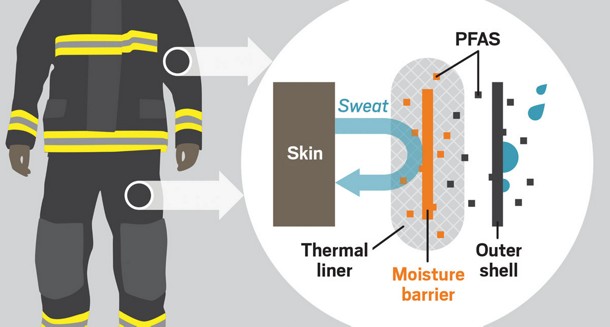Protective gear could expose firefighters to PFAS
By Raleigh McElvery | c&en | July 1, 2020

Read the full article by Raleigh McElvery (c&en)
“Firefighters face dangers beyond the blaze itself. Their work subjects them to carcinogens from burning materials, as well as toxic per- and polyfluoroalkyl substances (PFAS) from flame-suppressing foams. A new study finds that firefighters can also be exposed to PFAS over time through another source: their protective clothing (Environ. Sci. Technol. Lett. 2020, DOI: 10.1021/acs.estlett.0c00410).
Firefighters suffer from disproportionately high rates of cancer, including types that have been linked to PFAS exposure such as testicular cancer, prostate cancer, mesothelioma, and non-Hodgkin’s lymphoma. The clothing worn by firefighters, known as turnout gear, is made with fluoropolymer textiles and treated with PFAS for water resistance so that the material does not become soaked and heavy during use.
Graham F. Peaslee, a chemical physicist at the University of Notre Dame, began the study in 2017 when he was contacted by Diane Cotter. Her husband, a 28-year veteran of the Worcester (Massachusetts) Fire Department, had been diagnosed with advanced prostate cancer. Cotter had examined her husband’s gear and found that, while it appeared outwardly intact, there was serious fabric decay on the inside. Cotter wondered whether the uniform could be shedding toxic chemicals and asked Peaslee to take a look.
Peaslee uses nuclear techniques like particle-induced gamma-ray emission spectroscopy to measure the levels of fluorine in various consumer goods—from fast food wrappers to underwear. Based on fluorine levels, he can gauge the amount of PFAS present.
Cotter helped Peaslee collect more than 30 used and unused sets of turnout gear. Each set is made of an insulating cloth thermal layer with a moisture barrier at its center. The gear is coated on the outside with a water-resistant shell. Peaslee’s team found that the shell averaged just over 2% fluorine by weight, while the moisture barrier averaged more than 30% fluorine. Turnout gear, he says, contains “the most highly fluorinated textiles I’ve ever seen.”
Over time, as the layers rub against each other, PFAS from the moisture barrier and the outer shell appear to migrate to the thermal layer, which is PFAS-free when new but accumulates PFAS with time. PFAS may contact the skin via this layer, Peaslee says…”
This content provided by the PFAS Project.
Location:
Topics: